Shikoku Is Japan’s Overlooked Food and Adventure Paradise

This is the latest in The Daily Beast’s series on underrated destinations, It’s Still a Big World.
Spend enough time on social media, accruing an algorithmic scroll of myriad travel influencers, and you’ll get the sense that Japan is an all-out cacophony of vibey neon lights, ramen, anime fandom, cherry blossoms, Instagrammable street foods, and temples and shrines colliding with skyscrapers.
Indeed, most first-time travelers to Japan find themselves on the so-called “Golden Route”—usually some combination of Tokyo, Kyoto, Osaka, Hakone, and Hiroshima—which showcases the fast, the buzzy, the highly modern, and the well-preserved ancient.
The amount of time it takes to travel to Japan, and the overwhelming vastness of a city like Tokyo often makes any other itinerary seem second-tier, something to save for another time when you’re more seasoned and ready to dig into the deep cuts of the Land of the Rising Sun.
In my travels, I’m always searching for overlooked destinations, where the cuisine and cultural offerings are on par with far more popular locations nearby, but language barriers or a lack of foreign awareness and direct access, or even just limited marketing budgets, make them so-called “hidden gems.”
Shikoku, the smallest of Japan’s four main islands and home to some of the smallest prefectures in both population and geography, is one such place that has piqued my interest. It’s a mostly agricultural and mountainous island, a little larger than Connecticut and located towards the bottom of mainland Japan, just off the cities of Kobe and Hiroshima.
I had the opportunity to visit earlier this month, thanks to a press trip arranged by the Japan National Tourism Organization (JNTO), and I came away convinced that more travelers—first-timers or otherwise—should consider making it part of their itinerary.
The island of Shikoku consists of four small prefectures, and I visited the easternmost pair, Kagawa and Tokushima, the former of which is the only quick rail connection to mainland Japan.
Full disclosure, I speak a fair amount of Japanese, the product of an obsession with 1970s J-rock and six semesters of pandemic-era Zoom classes. And so I admit that engaging with this less-traveled region may have been easier for me than the majority of potential travelers seeking guidance here. I don’t take that for granted.
But there is no shortage of English-language guided tours should you want to go that route. The JNTO also has the resources for finding volunteer guides. And Japanese culture famously values hospitality, so if you go without a tour you will find that—language barrier be damned—everyone will do their best to make your visit a fulfilling one. You can absolutely do it; and it will be worth it.
Here’s what I experienced in Shikoku.
Kagawa, the “Udon Prefecture”
Perhaps the most famous of Shikoku’s four prefectures is Kagawa, which sits in the northeast corner of the island and is the smallest by size in all of Japan.
During my other trips to mainland Japan, almost everyone I spoke with seemed to have ties to Kagawa, and they beam with pride when the name comes up. A steakhouse chef in Kobe told me how his nonagenarian mother started their restaurant in Kagawa before coming over to the city now synonymous with beef; a local I met in an Osaka standing bar waxed nostalgic about shoyumame, a Kagawa comfort dish of broad beans simmered in soy that’s supposed to be, well, comforting (can confirm); an elderly road-tripper excitedly laid out his following week’s plans to finally visit Shikoku, circling the island starting in Kagawa.
Specific connections to the prefecture vary person to person, of course, but everyone I met always brought up one thing, often with an exclamation point: sanuki udon.
Named for Kagawa prefecture’s former provincial name, sanuki is uniquely chewy among udon varieties and features flat edges. The noodles are traditionally served in a bowl of their own starchy hot water, with a deeply umami dipping broth and toppings (often tempura) on the side.
Sanuki udon became the staple of Kagawa cuisine thanks to a climate and terrain more conducive to growing wheat than rice. It’s also the stuff of local legend: Ninth-century Buddhist monk Kūkai—whose 88 associated temples circle Shikoku island and are a major draw for tourist pilgrimages—is believed to have brought udon noodles back from his studies in China.
Kagawa is often referred to as the “Udon Prefecture,” and so I’m not exaggerating when I say udon is everywhere. Drive between towns—from Takamatsu to Marugame to Zentsuji, in my case—and it’s often just miles and miles of “うどん” signs poking out from single-story structures along the road.
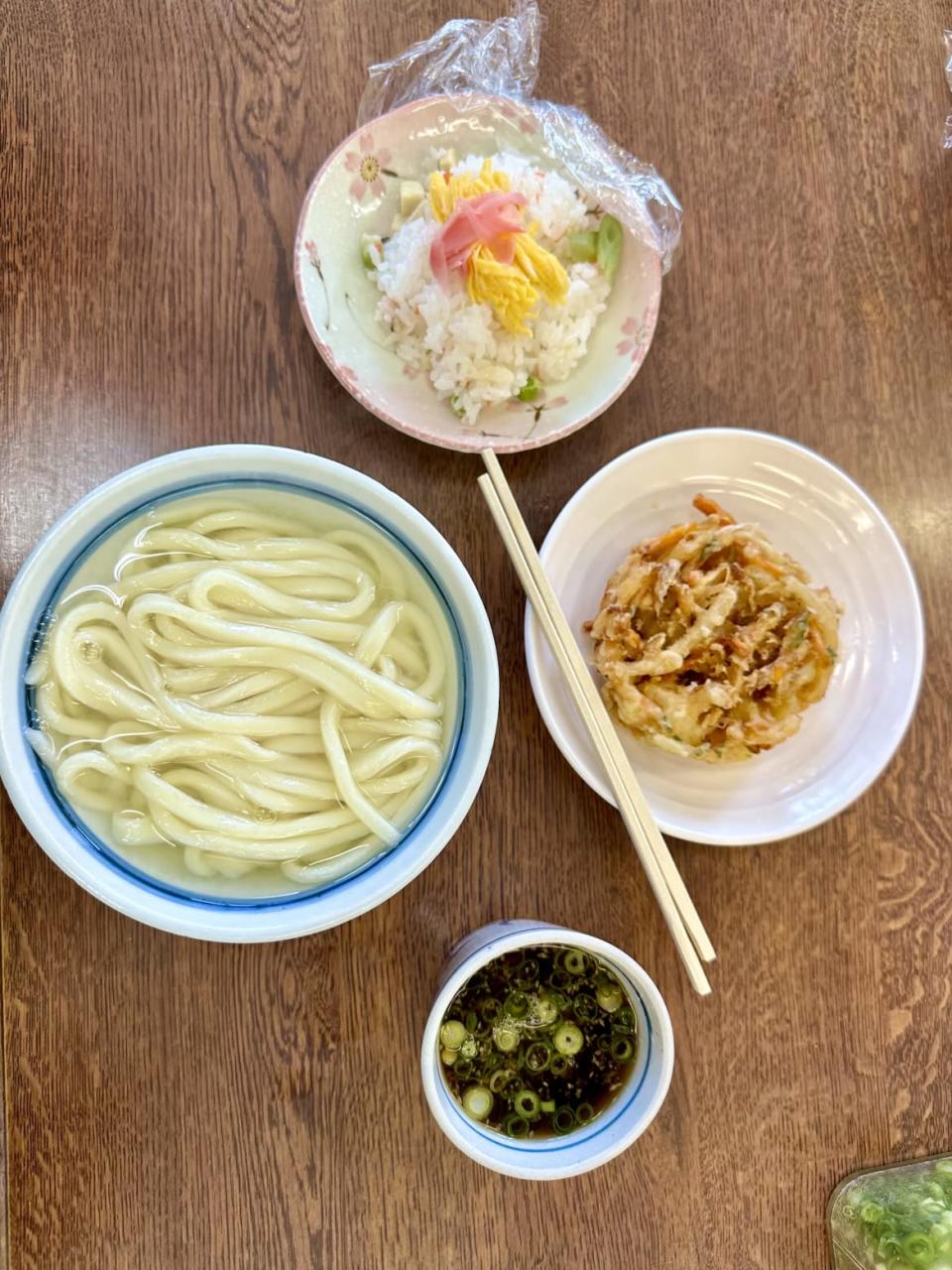
Sanuki udon at Nagata Udon near Kotohira, Japan.
With so many udon joints, how could anyone possibly know where to go? As with most food-related questions in Japan, follow the lines.
Spend time in Tokyo or Osaka and you quickly learn that queuing for a meal in Japan is an artform. In the big cities, it’s not unusual to see hour-long lines for anything from onigiri to ramen to viral cheese-stuffed pancakes. And yet it still came as a slight shock to see lines out the door at unassuming udon-ya in the outskirts of Kotohira, a small town of 8,000 and home to Shikoku’s largest Shinto shrine (at the end of a hike) as well as Japan’s oldest surviving kabuki playhouse.
We opted for an early lunch that day at Nagata Udon, a beloved cafeteria-style shop—its bustling parking lot in an otherwise sleepy part of town a dead giveaway of its merits. Inside, a no-frills wood-lined single room houses patrons seated arm-to-arm at communal tables, an orchestra of families, workers on lunch break, and elderly couples ordering, munching, and slurping in unison. It’s perfect.
Ordering is simple: Choose a noodle portion size, your hot or cold preference, and whatever sides are on offer. For me, that was a dippable nest of tempura veggies alongside a helping of seasoned rice topped with delicate slices of egg, tofu, and pickled ginger. Sure, I was ravenous from having just rode past a gazillion udon signs, but let’s just say I blackout ate. A second helping—okawari—would’ve gone down just as joyfully and just as quickly.
There is no shortage of ways to experience udon culture in Kagawa. Visitors can make the noodles themselves at the Nakano Udon School in Kotohira, where an exuberant sensei walks you through each step, including the traditional kneading by foot (marching to the tune of “Y.M.C.A.” no less). At Udon House, a B&B of sorts, visitors stay overnight after a full-day deep dive into udon culture, including hand-harvesting veggies and making the noodles and broth from scratch. There’s even an Udon Taxi service to drive you around the region to taste and compare multiple shops.
Takamatsu and the best chicken ever
If you ever make your way to Kagawa, whether via a one-night stopover or something larger like my trip, you will almost certainly find yourself in Takamatsu, the prefecture’s capital, largest city, and seaside hub.
Takamatsu is definitely not a city that most westerners would recognize—though bookworms may recall it as the main setting in Haruki Marukami’s Kafka on the Shore—and it isn’t typically heralded as an essential stop for first- or second-time travelers. But it’s got a fair amount worth the draw: The historic Ritsurin Garden, one of the largest strolling parks in all of Japan; gorgeous hills overlooking the Seto Inland Sea; a buzzing but not-so-overcrowded downtown with long arcades full of shops and nightlife; easy access to the mainland via a rare Shikoku-to-Honshu train line; and some of the best local bites I’ve come across in Japan.
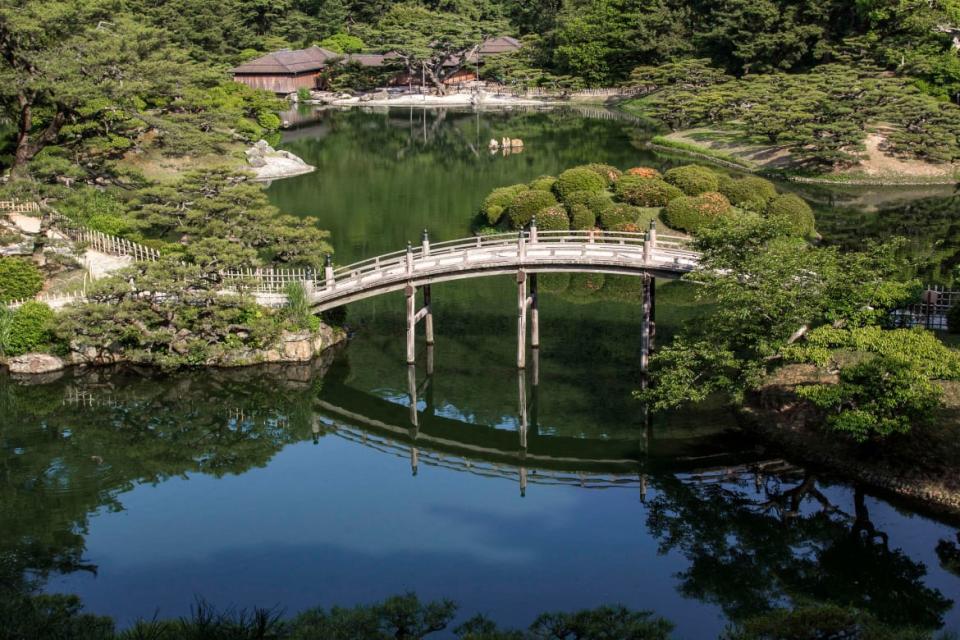
Ritsurin Garden in Takamatsu, Japan.
Yes, there’s sanuki udon—plenty of it. But udon isn’t the only local specialty of Kagawa. The prefecture’s Mediterranean climate means an abundance of citrus, leafy greens, and olives. The latter is found in countless regional products—olive chocolates, olive cider, and olive tempura—and as the feed for the region’s meat products: wagyu beef, pork, and chicken raised on the upcycled pulp of pressed olives; farmed yellowtail fed local olive powder.
The oleic acid from an olive-based diet is supposed to impart extra tenderness and umami to meat. The A4 beef I sampled in a Takamatsu izakaya did have an especially delicate flavor to it, though I didn’t notice much of a difference in the yellowtail sashimi I tasted in a kaiseki meal elsewhere in town.
But there’s one Kagawa dish that, to me, stood out above all the rest—even, wow, yes, sanuki udon. Allow me to briefly evangelize on the wonder that is honetsukidori, or, literally “bone-in chicken.”
Upon landing in Takamatsu on my first night of the trip, absolutely exhausted and disoriented after an 18-hour journey from New York, we wandered one of the city’s key shopping arcades (Lion Dori) in search of a quick bite before bed. Enter Ranmaru, a tiny izakaya whose door curtains appeared browned and dirtied at the edges—not a gross thing, but a heartening sign of its high customer foot traffic.
The pub, named for a pre-Edo hero remembered for his fierce loyalty, serves up local fare like the olive-fed beef and fish, but it’s the intoxicating smell of rendered chicken fat in the room that practically commands you to order the house dish.
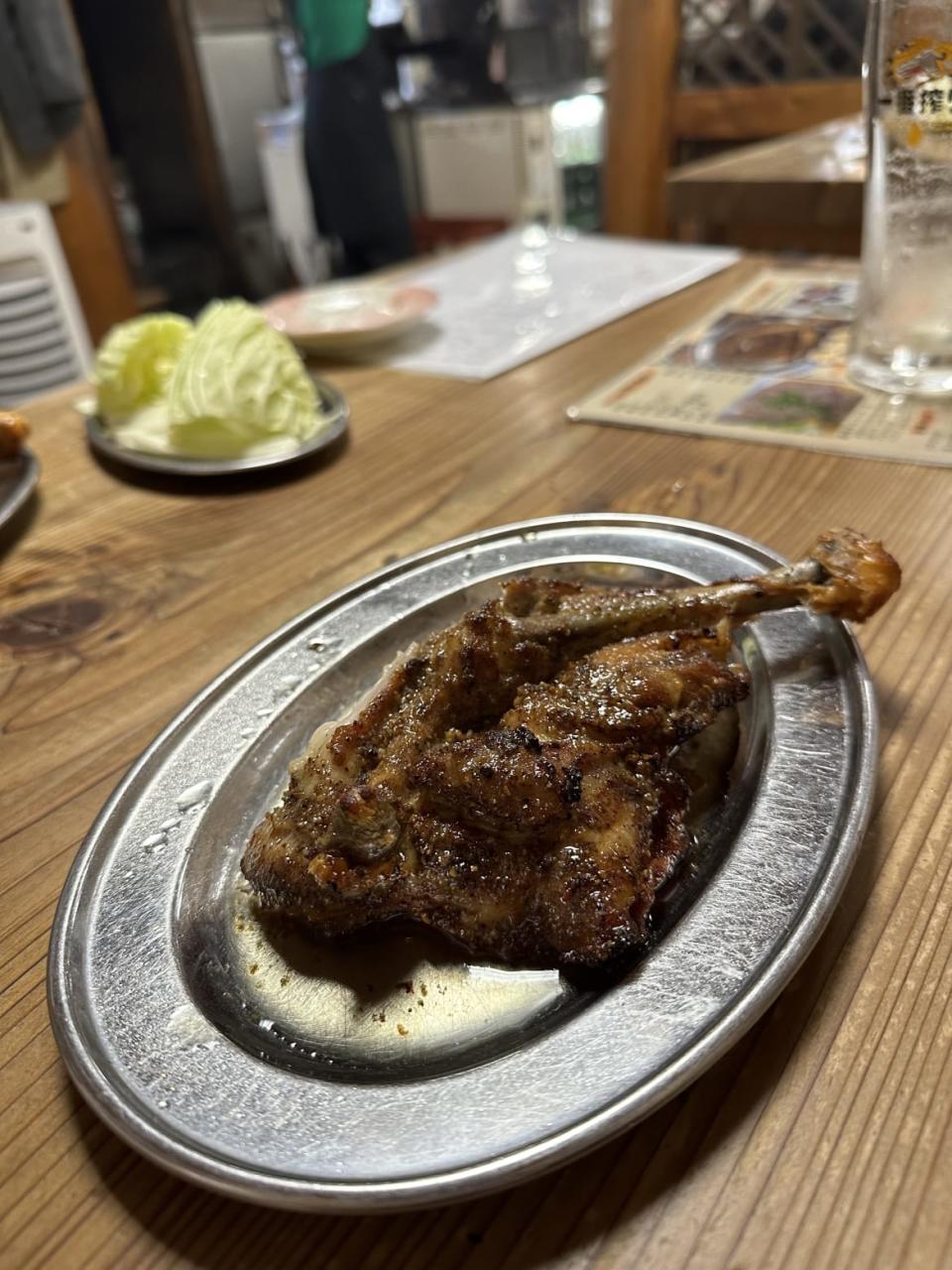
Honetsukidori, or bone-in chicken, at Ranmaru in Takamatsu, Japan.
A bone-in young chicken thigh is smothered in a heavy dose of coarse ground pepper and then roasted in chicken fat flavored with smashed garlic and ginger. The skin comes out perfectly crisped, the meat spicy and unbelievably juicy. Roughly chopped slices of raw cabbage are served on the side to sop up the drippings.
It sounds rather simple—and, sure, it is—but it’s one of the most memorable dishes I’ve ever had, Japan or otherwise. I ate two full orders, bought a fistful of seasoning packets at a gift shop in town, and now plan to talk about the dish for approximately forever.
Naoshima, the art island
For my first full day on Shikoku, I actually left for a different island—a much more popular one.
Most tourists who’ve ever set foot in Kagawa Prefecture likely did so via Naoshima, famous around the world as Japan’s “art island.” The tiny land mass nearly half the size of Manhattan features a dizzying array of contemporary art museums and installations set among hills overlooking the Seto Inland Sea or among traditional Japanese homes and temples. Visitors often rent bikes to navigate the short winding roads and take in the island’s fresh sea breeze.
I only spent six hours there, but the hype is definitely correct: I cannot overstate how powerful, thoughtful, and downright cool Naoshima is. And it is easily accessed via ferry from both Okayama on the mainland or, in my case, the port of Takamatsu, making it a must-stop for anyone traveling along the Golden Route or heeding my advice and making time for the Shikoku region.
My first stop after disembarking the ferry was Benesse Art Site, a contemporary museum attached to a boutique hotel, set on a dramatic hillside at the southern end of the island. The facilities, designed by Japanese architecture icon Tadao Andō, seamlessly blend with the natural environment, flush with sunlight much of the day.
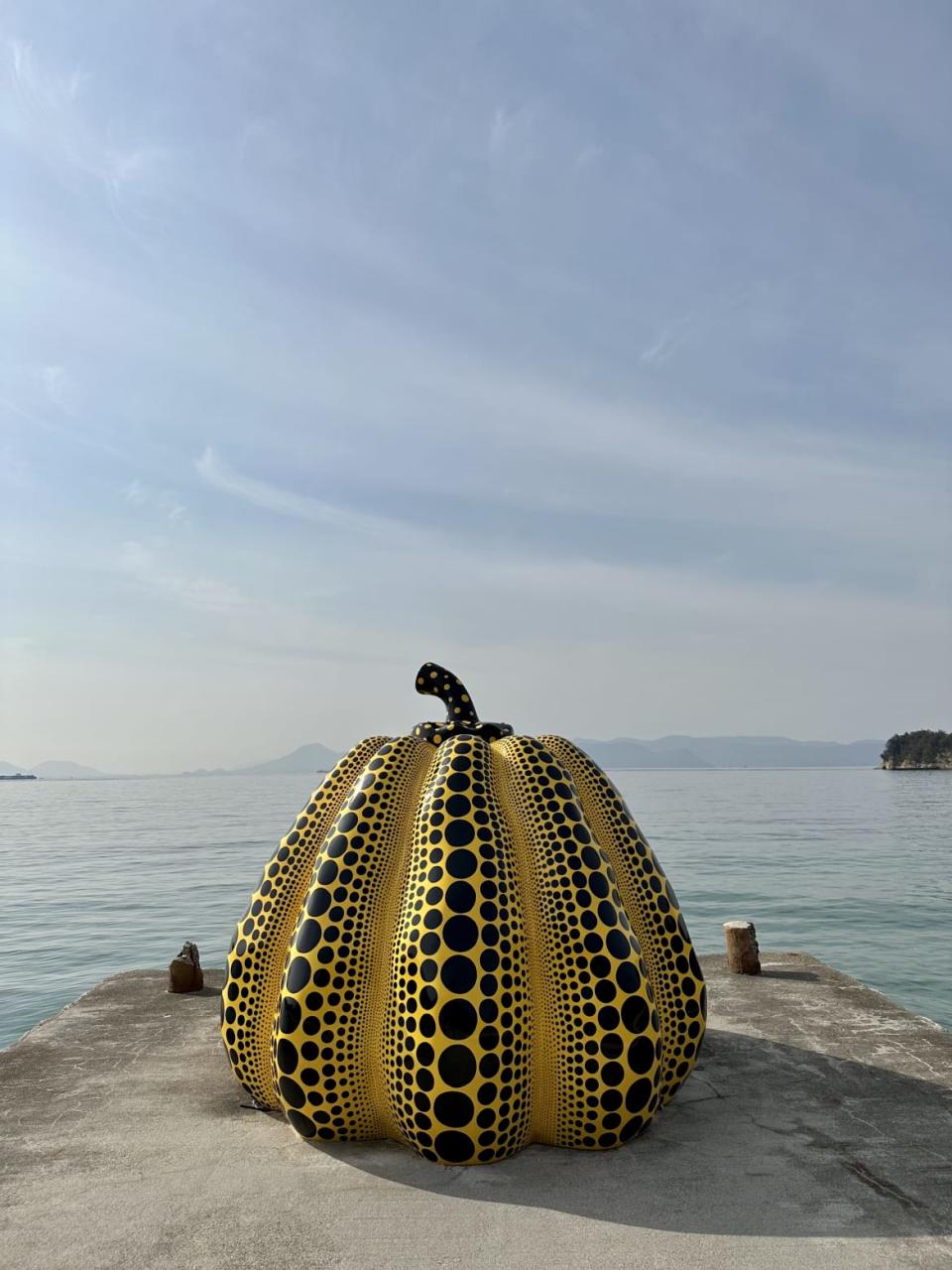
Yayoi Kusama’s famed yellow pumpkin sculpture in Naoshima, Japan.
Site-specific exhibits directly depend on and comment upon Naoshima’s landscape. The most famous example of this being Yayoi Kusama’s “Pumpkin” sculpture, which sits at the edge of a pier, juxtaposing the fake gourd’s brilliant yellow and black polka dots against the sparkling greens and blues of the surrounding area.
Less than a mile west is the Chichu Art Museum, another major attraction designed by Andō. As the name gives away (”chichu” means “in the earth”), this deeply serene gallery is carved into one of the highest points of the island, using only overhead natural light to illuminate its exhibits, including a room full of Monet’s “Water Lilies” oil paintings, which thus appear different depending on the time of day.
Other highlights include no less than three James Turrell installations, including Open Sky, a single room carved into marble with a rectangular hole at the ceiling, framing the open sky which then interacts with the interior’s ever-changing LED lights. It’s a strange experience, almost like looking upwards and out from inside some extraterrestrial monument. No photographs allowed at Chichu, so you’ll have to just take my word for it.
In the northeast corner of the island sits the Honmura district, notable for the ambitious Art House Project, which has taken seven different abandoned buildings among the residential area and turned them into art installations. An old dentist’s office now houses a collection of dream-like sculptures; a 200-year-old home is transformed into an indoor “sea of time” with LED counters placed by Naoshima residents; an abandoned shrine and its underground chamber are restored, with a narrow exit tunnel that evokes birth or death, depending your preference.
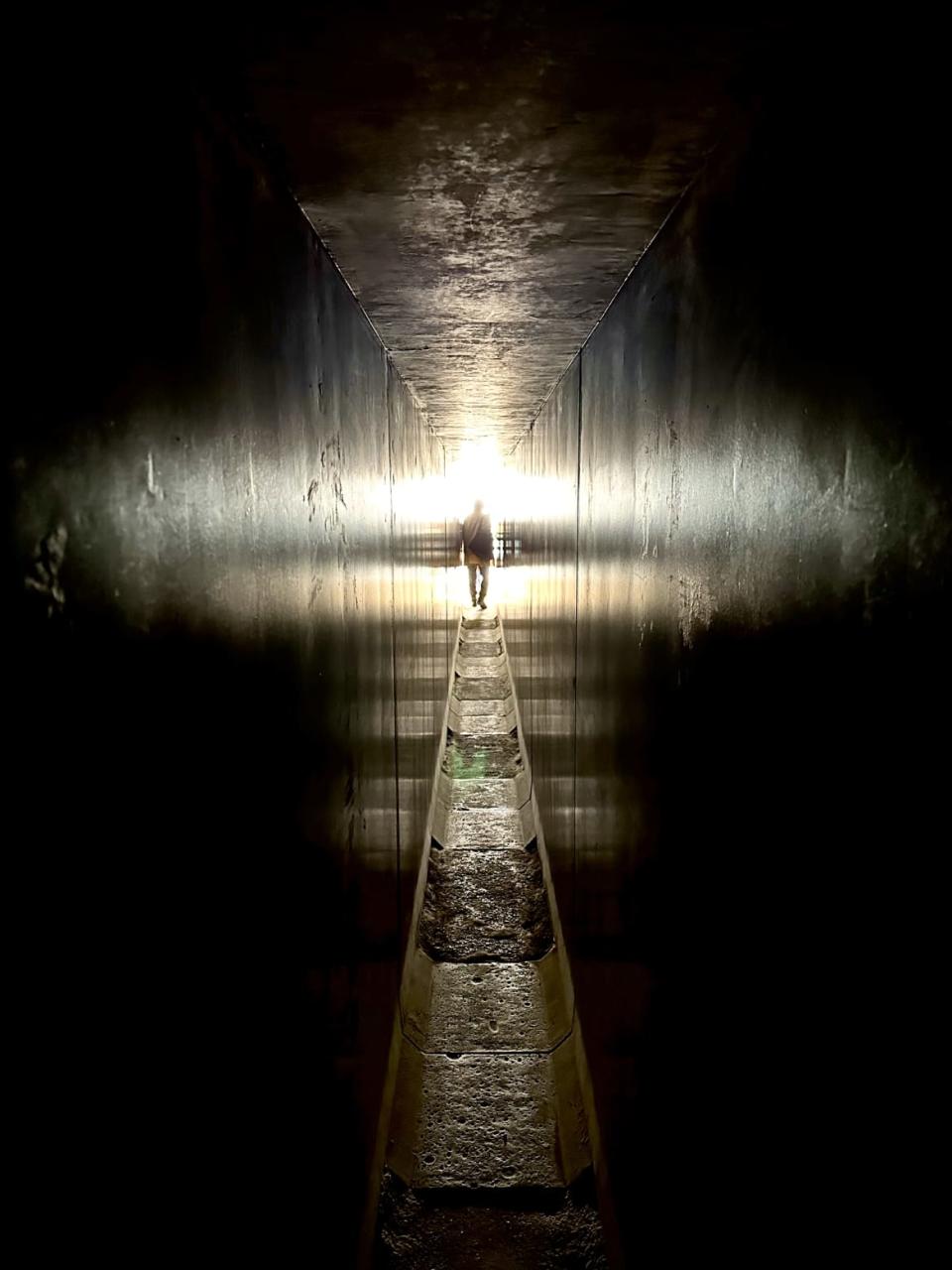
Exiting the Go’o Shrine in Naoshima, Japan.
The crowning exhibition is James Turrell’s Backside of the Moon, housed in a newly constructed building—designed by Andō, of course—where temples and shrines once stood. Visitors are ceremoniously led into the pitch-black room, fumbling over one another to take a seat inside. For the first few minutes of sitting in complete darkness, you may begin to disassociate a tad but as your eyes slowly adjust a dim light begins to appear on the far wall. That light, of course, has been there the entire time—you just don’t notice it until later.
It was a deeply moving experience for me, a career depressive. Even in total darkness, there’s always a light. I’ll happily confess I teared up.
The otherworldly Iya Valley
For the second half of the press trip, we headed 30 or so miles inland, south into Tokushima Prefecture via countless switchbacks along rolling cliffs completely covered in cedar trees, where we eventually encountered the Iya Valley. It’s an otherworldly landscape of dramatic mountains smashed up against one another, often with nary a person in sight, with steep gorges carved by the crystalline blue rivers now popular with whitewater rafters and sightseeing boats.
The valley is so isolated, thanks in part to the difficulty in building on such steep mountainsides, that it often feels like a vestige of the natural world, with largely untouched wilderness and geological marvels mere hours from the nonstop buzz of modern Japan.
In fact, the core legend behind Iya’s heritage is one of escape. The twelfth-century Heike clan, on the run after losing a war against its rival, retreated to this largely inaccessible valley. The warriors traversed the steep canyons by building bridges out of wisteria vine, an easily destroyed material should pursuing clans have caught up with them.
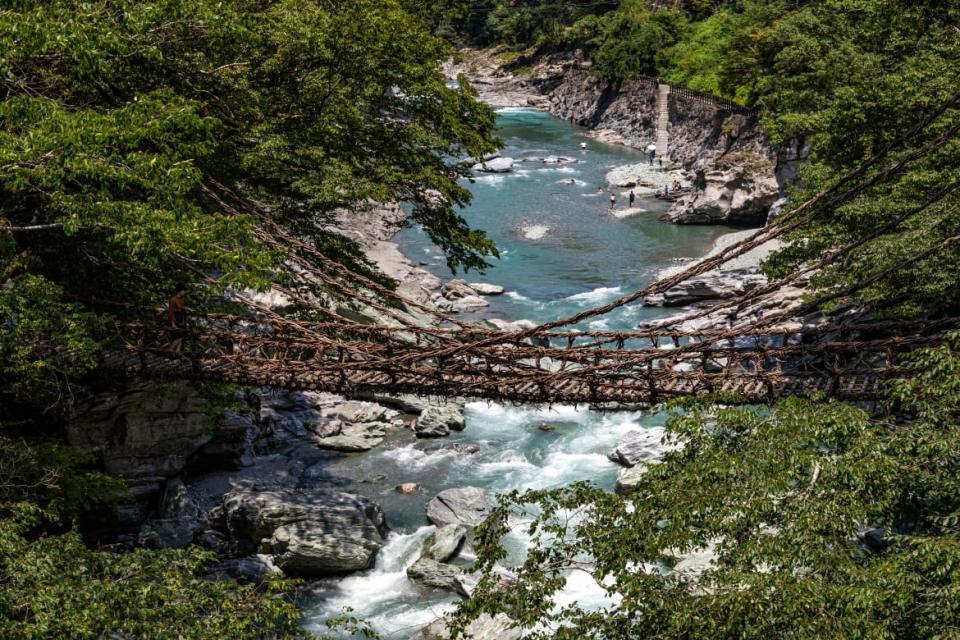
The kazurabashi suspension bridge made entirely of tree vine hovering over the Iya River.
Only three of those bridges, known as the kazurabashi, remain standing today. They’re all major tourist draws, despite the slightly knee-buckling experience of attempting to cross them. Don’t be ashamed to go slow and grab onto the sides for dear life—no one’s ego got in the way during my crossings. (And, of course, the bridges are lit up at night for a truly special sight.)
The region is covered in tokens of Iya Valley’s myth, lore, and sense of humor: A life-size ninja sculpture scales the outside wall of a soba shop overlooking one of the bridges; statues of supernatural spirits, including Konaki-jijii (crybaby old man), pop up along the treacherous mountain roads, ostensibly designed to scare children away from dangerous spots; and the tip of an especially gorgeous switchback is marked by the statue of a little boy pissing off the edge of the cliff, 600-odd feet straight down into the gorge below.
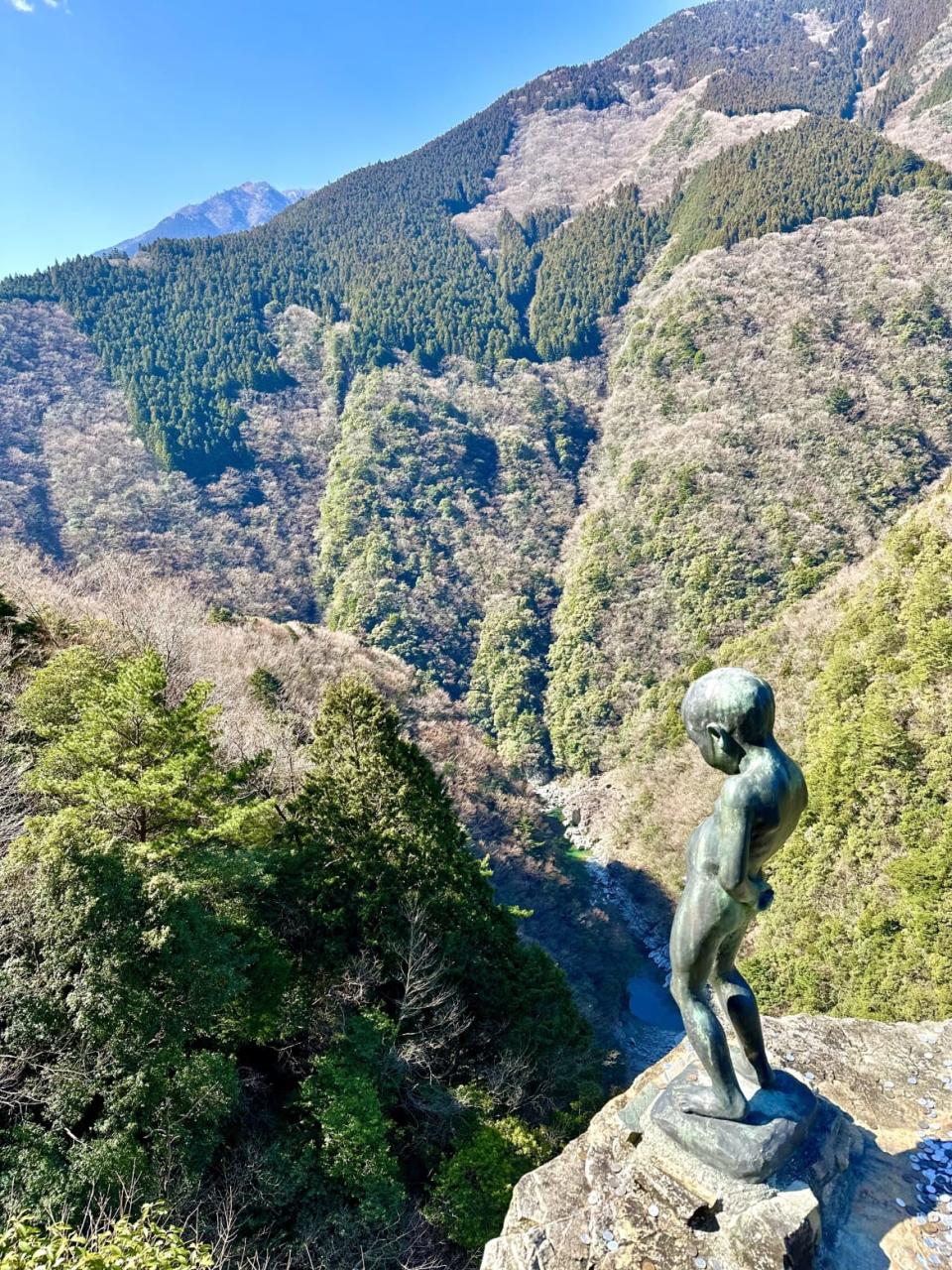
Statue of a Peeing Boy, Iya Valley, Japan.
The two most notable gorges in the valley are known as Ōboke and Koboke, meaning big and little dangerous steps, respectively. The Yoshino River views at any point—with deep evergreen flora, blue-emerald rapids, and eerily jagged geological strata fighting for your vision—rival anything I’ve seen in the American West or PNW (see this very article’s featured image up top).
Half-hour boat tours dispatch from calmer parts while daredevils from around the world flock to the narrower, rockier stretches of river for what’s alleged to be some of the best whitewater rafting in all of Japan.
The slopes of the Shikoku Mountain range here are so steep and so plentiful that locals have had to get creative for both safety and business purposes. Landslides were a common occurrence, so concrete walls mimicking the natural geology have been built along the roads—often fusing into the landscape, other times looking like giant dams. Hotels incorporate the steepness into their design.
Hotel Iyaonsen, for example, overlooks the same ravine as the peeing boy, and in order to reach its onsen baths, visitors must ride a cable car straight down the cliff to soak in the beautiful, naturally occurring sulfur hot springs. And at Hotel Kazurabashi, a short drive around the bend, visitors must take a cable car up the mountain to a series of hot-spring baths carved into the slopes. Meanwhile, Hotel Hikyo-no-Yu, where I stayed thanks to the JNTO’s assistance, is a split-level compound alongside the mountain, with the indoor baths overlooking a particularly scenic split in the hills, where the fog rolls in at dawn. Also, by the way, they serve fantastic Japanese dinner and breakfast.
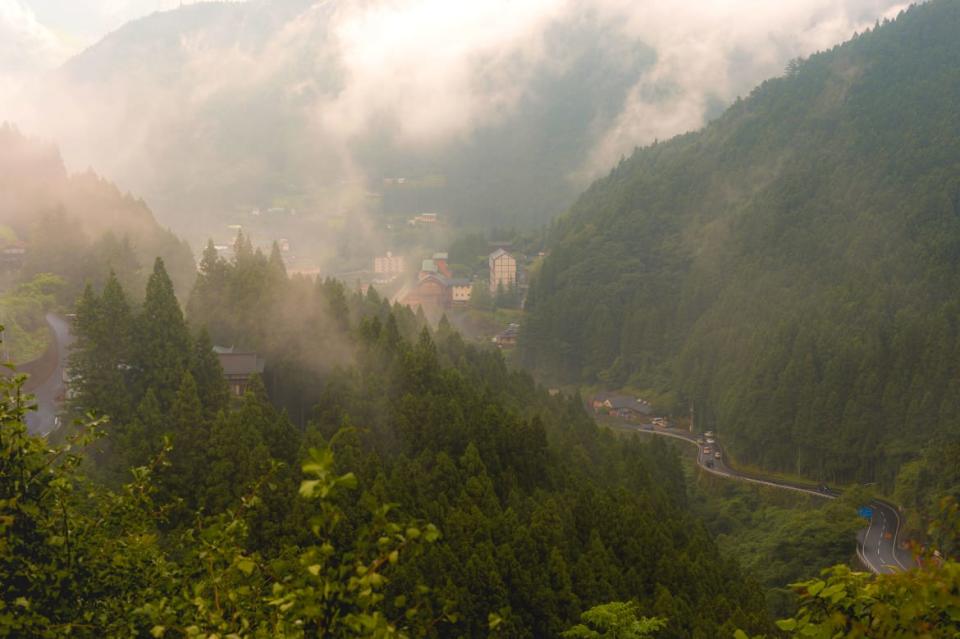
The Iya Valley covered by a mist in Shikoku, Japan.
Speaking of cuisine: With an entirely different terrain and climate in the Iya Valley comes a wildly different set of local specialties from Kagawa. For example, because rice and wheat are more difficult to cultivate here, buckwheat is consumed as a grain. As such, soba noodles are especially popular here—the local variation is both shorter and more tender than typical and served with a dried anchovy-based broth.
A small breed of river trout known as amego is popular both in meals and as a street snack. The fish is encrusted in salt, skewered, and slow-roasted over charcoal. It’s light in flavor, super flaky, and able to be eaten whole—crunchy little bones and all.
Every meal I had in the Iya Valley, whether a multi-course kaiseki or a quick bite, featured amego and ended with a bowl of soba. The locals know what they like—and rightly so.
Tokushima’s “vanishing side of Japan”
For the final night of the press trip, we ventured east of the Ōboke and Koboke gorges, deeper into the mountains—we’re talking deep, like near where roads shut down for the winter—to stay at the Tougenkyo-Iya Mountain Village, a collection of private farmhouses lining a zigzag road along the face of an especially conical hill.
Each of the traditional, thatch-roofed homes overlooks yet another series of slopes where the morning mist feels almost mythical and the nighttime stargazing is unbeatable. Dinner is delivered directly to your cottage in old-fashioned, multi-tiered picnic boxes and, of course, includes a large helping of buckwheat—both via whole grains with veggies in a dashi broth and a separate bowl of Iya soba.
The rental office is located at the foot of the hill, inside what appeared to be an abandoned elementary school. In fact, deserted school buildings are a common sight in this part of Tokushima Prefecture. A rapidly aging Japanese population, combined with mass migration to the big cities, has made some parts of the prefecture feel like real-life dioramic presentations about Japan’s “super-aging” society.

Life-size dolls displayed in the tiny village of Nagoro in western Japan.
And there’s no starker or more fascinating illustration of the “vanishing side of Japan,” as my guide repeatedly called it, than Nagoro.
The remote riverfront village was once home to roughly 300 people but, of course, that population has steadily dwindled to just two dozen. Tsukimi Ayano grew up in Nagoro but moved to Osaka and started a family there before returning in the early 2000s to take care of her ailing father who could no longer work. The story goes that she sewed together a scarecrow doll of his likeness to place in the fields, and then that one doll became several hundred, all modeled after real or imagined people from the town.
The result is an eerie but whimsical, almost Michel Gondry-like ghost town full of life-size dolls doing normal human stuff: One scarecrow fishes off the bridge; another six sit with bags in tow, huddled inside a bus stop; families worth of dolls sit out front of empty homes or fill old tea houses and offices; an abandoned schoolhouse is now filled with dozens of scarecrow pupils.
I visited Nagoro late in the morning, when the sun created a slight, mirage-like haze up the road as I walked along the river. Far up ahead at the edge of town, where Rte. 439 curves slightly to exit the village, I thought I’d spotted the only other person in Nagoro that morning, but alas, it was just a utility worker of the scarecrow species.
This odd relic of “vanishing Japan” may seem depressing—and it is, if you think about it only in the larger context—but it’s actually provided some hope to this rural part of the country. Fear not, as one local told me, German tourists absolutely love to visit.
It’s just one of the many attractions that makes Shikoku a slightly offbeat, culturally enriching experience.
Got a tip? Send it to The Daily Beast here
Get the Daily Beast's biggest scoops and scandals delivered right to your inbox. Sign up now.
Stay informed and gain unlimited access to the Daily Beast's unmatched reporting. Subscribe now.

 Yahoo Movies
Yahoo Movies 